NGB’s Perennial of the Year 2012: Heuchera
By Dan Heims
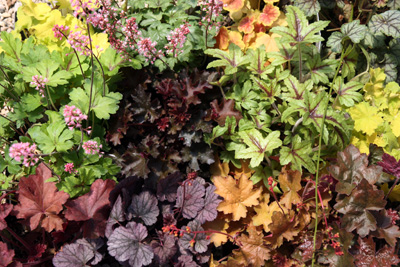
Heuchera Assortment
Each year the National Garden Bureau (NGB) selects one flower and one vegetable to be showcased. In 2012, they added a perennial to these selections. These crops are chosen because they are popular, easy-to-grow, widely adaptable, genetically diverse, and versatile. For the first ever perennial of the year, the NGB chose Heuchera.
Heucheras are all-American. Literally. Different species hail from the islands off the California coast to the highest mountains in the Rockies to the Gulf of Mexico. With this diverse range of habitat, these plants are able to find a niche in everyone’s garden. Breeders in America and Europe have taken a well-aimed swipe of a paintbrush between these species, and have assembled a plethora of plants with amazing flower and foliage forms that didn’t exist a scant ten years ago. Not only are these plants aesthetically pleasing, but they have become stronger, fuller, and more disease resistant. With few pests, great adaptability to containers and a seemingly unending number of forms, Heuchera should be in everyone’s garden!
History and Nomenclature
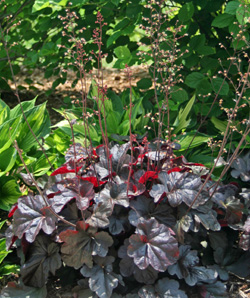
Heuchera ‘Obsidian’ Flowering
Can you say Johann Heinrich von Heucher? He was an Austrian professor of medicine and botany and a friend of Linnaeus, the father of taxonomy. Linnaeus would often name plants in honor of his friends and in 1738 he did so with von Heucher. Being Austrian, his name was pronounced “Hoyker,” and, you guessed it, the plant should be pronounced “Hoy-ker-uh.” Botanical illustrations have shown the plant in different European collections of American plants which date back to 1601.
Aside from the common name of coral bells, it was also called alum root due to its medicinal qualities. Native Americans used them to stop wounds from bleeding. The stems can be used in a pinch if you cut yourself in the garden.
The first American seed catalog was produced by a man known as Bernard M’Mahon in 1804. Heuchera americana, an east-coast native, was offered in this catalog.
While utilitarian and useful in shady spots, Heuchera did not stir the senses as they do now. The Victorian era was a boom period for many genera, but alas, these plants didn’t have the wow power to grab the color loving masses. Some Mexican collections including the “real” coral bells, Heuchera sanguinea, made it to Europe in the mid 1800s, and presented a new floral spectrum for breeding.
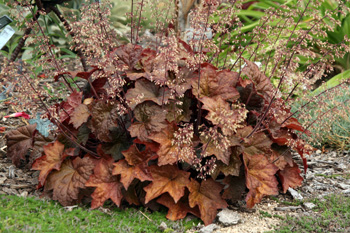
Heuchera ‘Palace Purple’ looking more coppery than purple!
It wasn’t until 1980 when Brian Halliwell released Heuchera villosa ‘Palace Purple’ that these plants were accepted as foliage plants. At about the same time, Dale Hendricks of Northcreek Nurseries released a strain of Heuchera americana called ‘Dale’s Strain’. These two plants were hybridized to form the first foliage varieties, and the rest, they say, is history.
Classification and Varieties
There are nearly 50 species of Heuchera inhabiting woodlands, prairies, and mountainous regions. Further south, Heuchera sanguinea, can be seen growing amidst cactus in Chihuahua, Mexico. The culture of these indigenous species must meet some of the same cultural requirements of their growing areas. By hybridizing, the ensuing plants carry the combination of traits and the end user gets the best of both worlds.
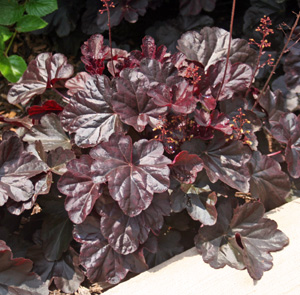
Heuchera ‘Obsidian’
These plants are in the Saxifrage family (Saxifragaceae) which includes Bergenia, Tiarella, Saxifraga (of rock gardens), Mukdenia and the giant-leaved Rodgersia. Tiarella, the foamflower of Eastern and western woodlands, is so genetically close to Heuchera that it can cross with it, giving rise to the intergeneric hybrid called Heucherella. By taking Heuchera, with its myriad forms and colors and crossing it to Tiarella, with a palette defined by leaf-shape, growth habit and dark-centers, a vast array of new hybrids have resulted. Some of the heuchera seen today can involve 5 separate species (and a hundred cultivars) and the Tiarella can carry the blood of 3 different species. Any math student understanding permutations will flip to the possibilities these crosses can present.
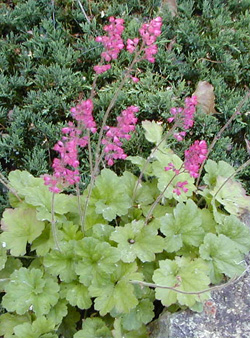
Green-leaved Heuchera with bright pink flowers.
The flowers are relatively dainty on most varieties of Heuchera with a color range of whites, pinks and reds. There are a few species cultivars which have a very pale yellow tone. Foliage can vary widely from the ½” wide leaves of Heuchera pulchella to the 11″ wide leaves of Heuchera villosa. Foliage colors of the species run from greens to olives to purple veins which are prominent in winter. Terra Nova Nurseries was at the forefront of the colored foliage boom with the selection of Heuchera ‘Amber Waves’ in 2000. In 12 years, this company has released an eye-crossing number of amazing cultivars with foliage in the palette of metallic rose, yellow, orange, red, velvety purple and black. Other breeders like Thierry Delabroye of France have produced a number of large leaved varieties, like ‘Brownies’ and the Big Top Series that are distributed by Ball Horticultural Company. Foliage can be matte or glossy, hairy or smooth, and can have contrasting veins which change color with the seasons. Early cultivars used to dictate, “If you want foliage you get lousy flowers, if you want great flowers, you get plain green leaves.” With today’s breeding, you get both on plants like ‘Rave On,’ ‘Swirling Fantasy,’ ‘Harvest Lemon Chiffon’ and ‘Shanghai.’ There is another class of ever bloomers like ‘Milan’ and ‘Paris’ which will both bloom until frost.
In the garden, different varieties fill different niches. Charles Oliver’s ‘Petite Pearl Fairy’ is a mass of color, perfect for the rock garden. Thierry Delabroye’s H. villosa hybrids like ‘Beaujolais’ work well in shady woodland settings. Most Heuchera work well in borders and especially in containers. Here they are especially useful as they don’t bully other plants and thrive on neglect while adding a perfect foil for other flowers (as well as having a wide range of foliage colors)! Other varieties like ‘Berry Smoothie’, ‘Caramel’ and ‘Stormy Seas’ are tolerant of a large range of conditions and fit into a “landscape” class of plants. Some plants like ‘Coral Forest’ and ‘Marvelous Marble’ fit into this class and are offered as seed strains from Syngenta. Ball offers the ‘Melting Fire’ strain with ruffled, dark brown leaves.
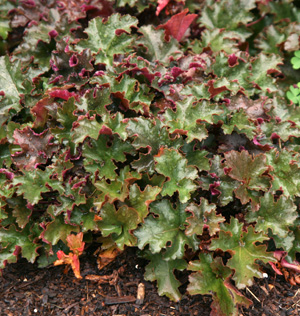
Heuchera ‘Chocolate Ruffles’
Before the new wave of hybrid Heuchera, many coral bells claimed a heritage that included only one species, H. sanguinea, the coral bells of your grandmother. Today, however, in order to give gardeners stronger, prettier plants, breeders are combining species so the newest coral bells provide a mix of outstanding characteristics. The common species used in today’s hybrids are H. sanguinea, H. americana, H. micrantha, H. villosa, and H cylindrica. ‘Chocolate Ruffles’, for example is hybrid between H. micrantha and H. americana and ‘Velvet Night’ is a hybrid between H. micrantha and H. americana. One of the most striking varieties, ‘Electra,’ was a mix of three species: americana, micrantha, and villosa. There are a number of straight species selections from seed like the ‘Palace Purple’ strain.
Though plant labels often do not list the Latin name (or the entire heritage), you can easily search online or talk to a knowledgeable nursery grower if you have a specific species you want. Here’s a brief primer on Heuchera species and their advantages.
- Heuchera americana likes woodland situations best, survives extreme hot and cold temperatures, offers an exceptionally tidy mounding habit and shows off the most exciting leaf patterns. ‘Green Spice’ and ‘Marvelous Marble’ strain from Syngenta are examples.
- H. villosa varieties, with their hairy, large leaves, are best for the deep South and any other hot, humid climate. H. villosa hybrids are especially popular. ‘Caramel’ is a newer selection with gorgeous apricot leaves in spring that turn amber in summer and reddish in fall. ‘Citronelle’ and ‘Electric Lime’ display foliage that’s stunning chartreuse. ‘Southern Comfort,’ the Big Top Series and ‘Georgia Peach’ have strong H. villosa heritage as well.
- H. micrantha, a native to the West Coast, tolerates wet roots better than other coral bell varieties. These lend their wavy leaves to any hybrid, ruffled form on the market today.
- H. cylindrica presents a more compact form with strong, rigid flower stems that stand up to windy conditions. These are very attractive to bees and butterflies. This species is not as eye-catching as its more showy sister species due to its green or white blooms. Try ‘Greenfinch’ for its fresh green flowers on short panicles.
-
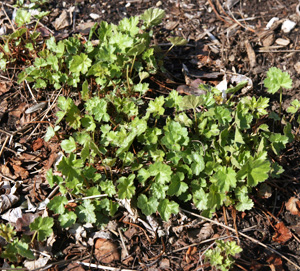
Heuchera sanguinea in early spring.
Heuchera sanguinea in early spring.H. sanguinea, a Southwestern native, maintains its often-bright blooms through extreme drought and heat. Most do well in shady rock gardens or along woodland paths. Look to bold varieties such as ‘Snow Angel’ with mottled green and cream leaves or ‘Firefly’ strain or the ‘Coral Forest’ strain with profuse scarlet blossoms.
Color your Garden by Number
The following list will assist you in selecting plants in specific color schemes. Landscape designers can use this list to select plants suitable for their region and for “sub” lists when certain cultivars are not available.
Amber-Peach
‘Georgia Peach’
‘Ginger Ale’
‘Midas Touch’
‘Maroon Blush’
‘Pinot Gris’
Green
‘Apple Crisp’
‘Green Spice’
‘Malachite’
‘Mint Julep’
‘Paris’
‘Peppermint Spice’
Red
‘Autumn Leaves’
‘Fire Chief’
‘Cherry Cola’
Black
‘Black Beauty’
‘Creole Nights’
‘Midnight Rose’
‘Obsidian’
Lime-Yellow
‘Citronelle’
‘Electra’
‘Electric Lime’
‘Lime Marmalade’
‘Lime Rickey’
‘Pear Crisp’
Seasonally Multicolored
‘Cajun Fire’
‘Miracle’
Brown
‘Cherries Jubilee’
‘Chocolate Ruffles’
‘Mahogany’
‘Mocha’
‘Molly Bush’
‘Root Beer’
‘Vesuvius’
Orange
‘Delta Dawn’
‘Marmalade’
‘Peach Flambé’
‘Southern Comfort’
‘Tiramisu’
Silver
‘Amethyst Myst’
‘Cinnabar Silver’
‘Gypsy Dancer’
‘Harvest Burgundy’
‘Mocha Mint’
‘Plum Pudding’
‘Rave On’
‘Silver Scrolls’
‘Prince of Silver’
Gold
‘Amber Waves’
‘Caramel’
Purples
‘Amethyst Myst’
‘Berry Smoothie’
‘Big Top Burgundy’
‘Frosted Violet’
‘Midnight Bayou’
‘Plum Pudding’
‘Plum Royale’
‘Purple Petticoats’
Silver with Green Veins
‘Color Dream’
‘Green Spice’
‘Harvest Silver’
‘Magic Color’
‘Mars’
‘Mint Julep’
‘Neptune’
‘Saturn’
‘Venus’
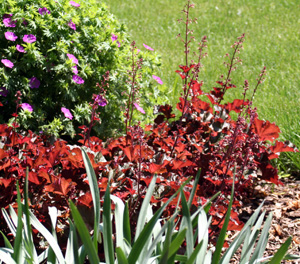
Heucheras offer foliar color and contrast in the landscape.
Culture and Garden Preferences
Heucheras offer foliar color and contrast in the landscape. Heuchera require well-drained soil. If you’ve had problems with coral bells in the past, most likely you’ve tried to plant them in soil that’s too wet or full of clay. To solve that, plant your Heucheras in raised beds, on a berm, or in containers. Even mounding the soil slightly where you plant them will help. A premium organic planting compost will provide excellent drainage with enough moisture.
Other than keeping the soil well-drained and mulched, coral bells have very few other maintenance needs. Let them dry between watering, refrain from using excess fertilizer, and give them neutral or slightly acidic soil (the perfect ph is 5.8 to 6.3, but most aren’t too fussy).
Many coral bells do well in part sun, but stay away from hot afternoon rays—foliage will often fade, wilt, or scorch under intense sunlight. Instead, provide shade during the hottest times of the day, or plant where your Heuchera will get consistent full or filtered shade.
Heuchera are remarkable for needing little care. When flowers fade, they can be spun off with a flick of the wrist. If stems get too long they can be cut off with the resulting stub resprouting and the piece in your hand replanted to form a new plant. This helps keep your Heuchera compact.
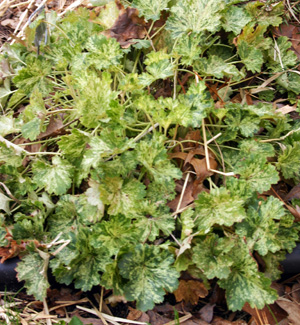
Heuchera ‘Snow Angel’
When using “heuchs” in the landscape, they are best triangulated with most varieties planted 24 inches on center. You will have to look at the spread on the label to determine the best spacing. Three words are essential: drainage, drainage, drainage. Most varieties are drought-tolerant as well.
Note that as coral bells grow, their crowns rise up and out of the soil slightly. Either mulch to protect the crown, or lift, divide and replant. It’s best to divide them every two to three years, with the spring being the best time to do this work.
If necessary, cut back winter-damaged foliage in early spring to make way for new growth. And if you live in a cold climate (Z4), mulch your coral bells in winter, leaving the crowns unburied. Oak leaves are ideal.
Propagation
While most Heuchera are initially propagated by tissue-culture, they can be divided by a sharp shovel in early spring when the soil has thawed. A two-year-old plant can easily be divided into 6 plants. Place the divisions buried to the crown in enriched soil and water in. Foliage may have to be removed if any wilting is observed.
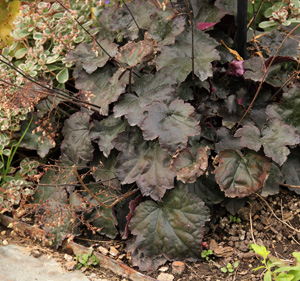
Heuchera ‘Blackout’
Starting from Seed
Coral bells can be bought in seed packets. These are usually H. sanguinea types and are fairly true from seed. Fancy-leaved “heuchs” are grown from tissue culture and are all wide-ranging hybrids, so seedlings of these plants would be variable and inferior to the parent. Heuchera have very fine seed and must be sown on top of the medium to germinate. Thoroughly moisten sterile seed-starting mix and then fill your seed tray to the top. Soil can be gently tamped. Seed must be sowed sparingly. Otherwise the mat of dense seedlings will be nearly impossible to pull apart. Germination usually begins after 8 to 14 days in soil that is at a temperature of 70º-72ºF.
Once the tiny plants have 3-4 true leaves, they can be transplanted to cell packs or a soil flat to grow on. When plants are 3″ across, they can be transferred to pots or the garden and watered gently. If they are being moved into full sun, it must be done gradually over a week’s time or they will burn badly.
Pests
“Heuchs” have relatively few pests but they do have one nemesis: strawberry or black vine weevil. If you have had plants whose tops “fall off” in the spring, they are being eaten underground by these little monsters. These are creamy-white c-shaped grubs. You must fight with a twofold attack; the brown or black adults are out in late May to early June (watch for munched leaves) and can be sprayed with Bonide Systemic Insect Control. DO spray at night as that’s when they come to play (and eat). In fall, beneficial nematodes like NemaGlobe can be sprayed over the soil around the plants. Remember to water before and after the application to get these critters in the soil. Each adult can lay 300 eggs, so control is highly advised. Organic gardeners who experience the tops of plants falling off (from weevil damage) can pour hot water on the ground to kill existing larvae.
Diseases
There are two diseases you might see on Heuchera: mildew and rust. Mildew tends only to attack varieties of Heuchera sanguinea. Organic controls such as baking soda in water can provide some prevention. Mancozeb can be applied as both a preventative and a remedy. Rust can be a severe problem if the plants are moist and the temperature is in the 45º -50ºF range. Plants will appear dark-spotted from above and when a leaf is turned over, orange patches are evident. While rust won’t kill a plant, it is quite ugly and contagious. Preventative measures include clean, dry facilities (for growers) and copper-based sprays as used on fruit trees. Mancozeb, Cleary’s or Daconil can also prevent an attack and provide long-term control. Yellow-leaved heuchera seem most susceptible. Once a plant has been attacked, remove the affected leaves and apply one of the above sprays. Clean equipment with alcohol after use.
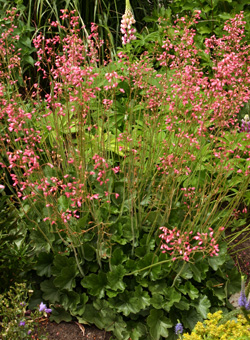
A green-leaved Heuchera in bloom.
Coral Bells as Cut Flowers or Cut Foliage
A green-leaved Heuchera in bloom.Surprisingly, Heuchera leaves also offer extremely long-lasting foliage for fresh-cut arrangements. Add them to your floral bouquets by cutting the leaves so each one has a fairly long stem and then stick them immediately in water with the flowers of your choosing. Change the water weekly and Heuchera leaves can live up to two years in a vase. (They’ll even start rooting eventually!)
Try pairing the deep purple leaves of ‘Dark Secret’, ‘Plum Royale’ or ‘Berry Smoothie’ with a spray of yellow coreopsis or a few choice lilies. Marry the chartreuse of ‘Lime Marmalade’ with blue bachelor’s buttons and orange California poppies. Or, arrange the bold orange leaves of ‘Peach Flambe’ or ‘Tara’ with green hydrangeas, zinnias or purple salvia. To play up the color silver, combine a silver-toned coral bell like ‘Rave On’ or ‘Silver Scrolls’ with white daisies, roses or lilies. Tulip flowers in dusky purples and black work quite nicely with dark leaved “heuchs”. European florists are rolling the leaves around roses for a cool effect. We have seen leaves used in wedding bouquets accented with Hypericum berries.
– from the National Garden Bureau. The National Garden Bureau recognizes Dan Heims as the author of this fact sheet. Dan speaks worldwide on his plants and his craft.
